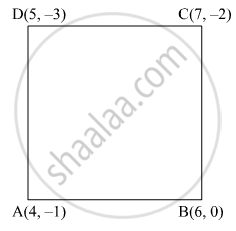Advertisements
Advertisements
प्रश्न
Show that A(4, –1), B(6, 0), C(7, –2) and D(5, –3) are vertices of a square.
उत्तर

The given points are A(4, –1), B(6, 0), C(7, –2) and D(5, –3).
AB = \[\sqrt{\left( 6 - 4 \right)^2 + \left( 0 + 1 \right)^2} = \sqrt{4 + 1} = \sqrt{5}\]
BC =\[\sqrt{\left( 6 - 7 \right)^2 + \left( 0 + 2 \right)^2} = \sqrt{1 + 4} = \sqrt{5}\]
CD =\[\sqrt{\left( 7 - 5 \right)^2 + \left( - 2 + 3 \right)^2} = \sqrt{4 + 1} = \sqrt{5}\]
AD = \[\sqrt{\left( 5 - 4 \right)^2 + \left( - 3 + 1 \right)^2} = \sqrt{1 + 4} = \sqrt{5}\]
AB = BC = CD = DA
Slope of AB = \[\frac{0 + 1}{6 - 4} = \frac{1}{2}\]
Slope of BC = \[\frac{- 2 - 0}{7 - 6} = - 2\]
Slope of CD = \[\frac{- 3 + 2}{5 - 7} = \frac{1}{2}\]
Slope of AD = \[\frac{- 3 + 1}{5 - 4} = - 2\]
Thus, AB perpendicular to BC and AD. Also, CD perpendicular to AD and AB.
So, all the sides are equal to each other and are perpendicular.
Thus, they form a square.
APPEARS IN
संबंधित प्रश्न
Find the slope of the line with inclination 30° .
Without using the distance formula, show that the points A(4, −2), B(−4, 4) and C(10, 6) are the vertices of a right-angled triangle.
(−2, 4), (4, 8), (10, 7) and (11, –5) are the vertices of a quadrilateral. Show that the quadrilateral, obtained on joining the mid-points of its sides, is a parallelogram.
A(5, 4), B(−3, −2) and C(1, −8) are the vertices of a triangle ABC. Find:
- the slope of the altitude of AB,
- the slope of the median AD and
- the slope of the line parallel to AC.
Find the slope and the inclination of the line AB if : A = (−3, −2) and B = (1, 2)
The points (−3, 2), (2, −1) and (a, 4) are collinear. Find a.
Determine x so that the slope of the line through (1, 4) and (x, 2) is 2.
Determine whether the following point is collinear.
A(–4, 4), \[K\left( - 2, \frac{5}{2} \right),\] N (4, –2)
Find k, if B(k, –5), C (1, 2) and slope of the line is 7.
Fill in the blank using correct alternative.
Distance of point (–3, 4) from the origin is ______.
Find the slope of a line passing through the points (x, 9) and (12, 6) is `(-1)/3 = ("y"_2 - "y"_1)/("x"_2 - "x"_1)`
Find the slope of a line passing through the following pair of points
(5pq,p2q) and (5qr,qr2)
Find m if the slope of the line passing through the point (-7,5) and (2,m) is `1/3`
Find slope of a line passing through the points A(3, 1) and B(5, 3).
Find the slope of the line passing through the points A(6, -2) and B(–3, 4).
Find the value, of k, if the line represented by kx – 5y + 4 = 0 and 4x – 2y + 5 = 0 are perpendicular to each other.
Show that the points A(- 2, 5), B(2, – 3) and C(0, 1) are collinear.
Prove that A(4, 3), B(6, 4), C(5, 6) and D(3, 5) are the angular points of a square.
Find the slope of the line passing through given points G(3, 7) and K(–2, –3).
